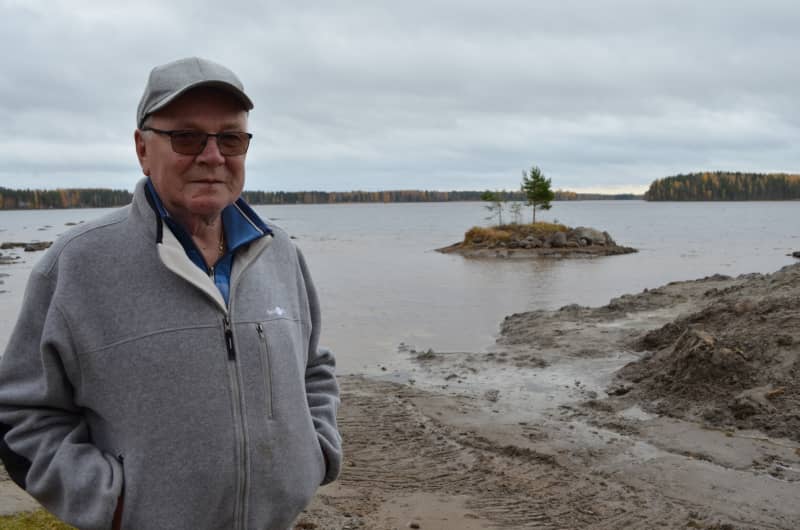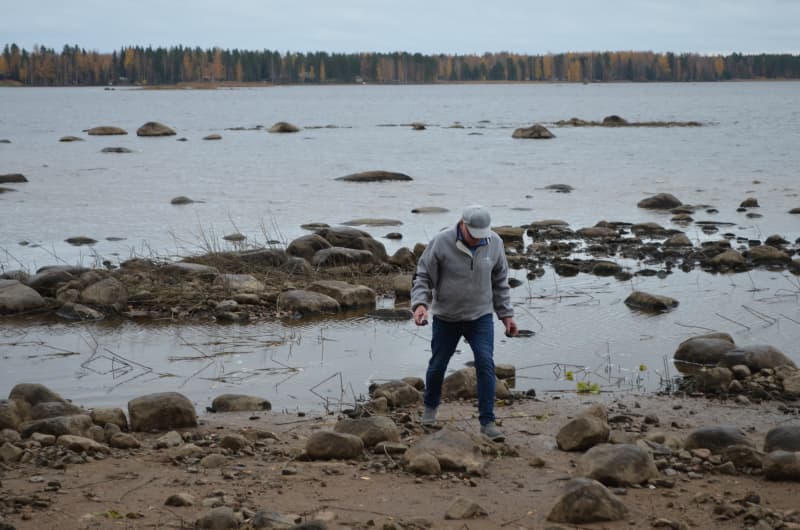The water level of Jääskänjärvi in \u200b\u200bAlavu was lowered during the fall and winter so that the beaches can be dredged. In Jääskänjärvi, as dredging progressed, the lake’s large number of small lake mussels has been marveled at.
At Lake Jääskänjärvi in \u200b\u200bAlavu in South Ostrobothnia, the drop in the water level has brought plenty of little lake mussels to the cottage beaches.
The little lake mussel is the most common mussel species in Finnish lakes. It is found all over our country, although the same mussel species has already become rarer in other parts of Europe.
Mussels have increased in Jääskänjärvi as the lake’s water quality has improved, although the little lake mussel is known to survive in slightly eutrophic and nutrient-poor waters.
The lake’s water quality has varied
– There has been good and bad water. When we came here 45 years ago, the water was so clear that we breezed on the lake and you could see the bottom almost everywhere.
At worst, according to Käpynen, the quality of the water has been so bad that it has been necessary to take a shower after a swimming trip.
Käpynen estimates that the variation in the lake’s water quality has been caused by the removal of peat.
– When peat was once lifted, there was not enough monitoring and sewage sludge got into the lake from the drainage ditches. As monitoring improved, the lake’s water quality has improved.

\”Clams almost to the point of trouble\”
During the last ten years, however, the water quality of Jääskänjärvi has improved again. At the same time, small lake mussels have increased in abundance in the lake, Rauni Käpynen knows.
– There are almost too many of them now. The shell of the clam is sharp. If you step on the open shell with your bare feet, you can also get a wound.
Cottage beaches in Jääskänjärvi have been renovated this autumn. The dredging became possible when the ely center temporarily lowered the lake’s water level by 80 centimeters. When the water level receded, the true number of mussels was revealed on many beach huts.
– They went in flocks with the water and some stayed on dry land. The crows have had a time of feasting, when the birds have only had to peck them from that shore.
Clams heal the ecosystem
– That’s a good sign. Mussels have a healing effect on the entire water ecosystem of the lake. They filter matter from lake water into food for benthic animals. Benthic animals, on the other hand, are food for fish.
Taskinen advises beach owners to throw live mussels left on dry land back into the water.
– If there is time for such a rescue operation, it will help the mussels survive the winter. In winter, it is important that the ice does not reach the shells. Of course, they also burrow into the bottom sediment there.
Any pearls?
At the time of the interview, a few shells and empty shells can be seen on the headland of Rauni Käpynen’s cottage beach. Käpynen is no longer excited about collecting shells, which is usually a pleasant activity for children.
– I don’t think you can find a single gem in them, so it’s not worth it either, the experienced camper smiles.
Would there be a small chance?
– I don’t know, I should really look at it sometime, but I doubt it, Rauni Käpynen answers.
Professor Jouni Taskinen says that small lake mussels may also contain vague, pearl-like stones a millimeter or two long, but the mussel species in question does not live to be old enough to grow them into pearls.
Pearls are the treasures of river pearl mussels. Raakus live to be 100–200 years old.
Jouni Taskinen finds out that the age of the river pearl mussel collected in the Salmus project from Utsjoki last year was accurately determined. Researchers at the University of Jyväskylä found that the creature is a handsome 254 years old.
According to Taskinen, seven species of mussels live in Finland.
In addition to the small lake mussel, there are big lake and flat lake mussels in the lakes. There are also three species of river mussels: soukkojoki, sysijoki and vollejoki.
In addition to these, there is also the highly endangered river pearl mussel, or rakku. Raakku is naturally calmed, just like the tidal river mussel.
Pebbles and cloaked frogs
In addition to mussels, beach dredging brought out the stones of Rauni Käpynen’s cabin beach in Jääskänjärvi. The same happened on many other beaches.
– When we get the rocks out and the beach a little deeper, it will be easier to travel by boat than before. The swimming place is also improved when you can get wet a little closer to the shore than before, Rauni Käpynen explains the benefits of dredging.

Jääskänjärvi has around 120 cabins and a dozen permanent residences. Käpynen estimates that about 30 dredgings, enabled by the ely center but financed by the beach owners themselves, have been carried out so far on about 30 beaches.
In Jääskänjärvi, in addition to small lake mussels, there are also nesting areas of the cape frog.
– Cloaked frogs are tranquilized, so digging in those areas is not allowed.
In addition to shore dredging, Jääskänjärvi is also undergoing a general lake restoration project. During the last summer, a new dam and fish ladder were built on the lake.
Flood waters fill the lake in spring
The water level of Lake Jääskänjärvi will be raised to normal height in the spring of 2023 with the help of flood waters.
Jääskänjärvi belongs to the regulated top lakes of Nurmonjoki. Ely Center of Southern Ostrobothnia is responsible for regulation. The lakes are regulated to reduce the flooding of Nurmon and Lapuanjoki. In the future, the regulations will change.
– The regulation of the lake level will no longer be as great as it was until now, says Rauni Käpynen.
Käpynen is looking forward to the coming cottage summers on his re-dredged cottage beach.
– It’s nice if the beach is in such condition that your feet don’t sink into mud holes.

